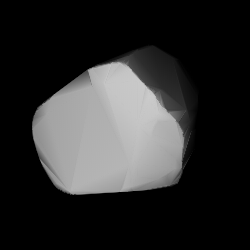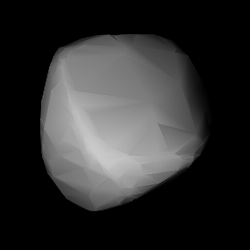763 Cupido is a Flora asteroid, tumbler and slow rotator from the inner regions of the asteroid belt, approximately 7 kilometers in diameter. It was discovered on 25 September 1913, by German astronomer Franz Kaiser at the Heidelberg-Königstuhl State Observatory in southwest Germany. The S/L-type asteroid has an exceptionally long rotation period of 151 hours. It was named by its Latin name after Cupid, the Roman god of erotic love, attraction and affection.

810 Atossa is a bright and elongated background asteroid from the region of the Flora family, located in the inner portion of the asteroid belt. It was discovered on 8 September 1915, by German astronomer Max Wolf at the Heidelberg-Königstuhl State Observatory in southern Germany. The presumed S-type asteroid has a rotation period of 4.4 hours and measures approximately 8 kilometers in diameter. It was named after the ancient Persian queen Atossa.
1020 Arcadia, provisional designation 1924 QV, is a stony Agnia asteroid from the central regions of the asteroid belt, approximately 11 kilometers in diameter. It was discovered on 7 March 1924, by German astronomer Karl Reinmuth at the Heidelberg Observatory in Heidelberg, Germany. The asteroid was named after the Greek region of Arcadia.

1058 Grubba, provisional designation 1925 MA, is a stony Flora asteroid from the inner regions of the asteroid belt. It was discovered on 22 June 1925, by Soviet–Russian astronomer Grigory Shajn at the Simeiz Observatory on the Crimean peninsula. The S-type asteroid was named for Irish telescope maker Howard Grubb. It has a longer-than average rotation period of 46.30 hours and measures approximately 12 kilometers in diameter.
2531 Cambridge, provisional designation 1980 LD, is a stony Eoan asteroid from the outer regions of the asteroid belt, approximately 20 kilometers in diameter. It was discovered on 11 June 1980, by American astronomer Edward Bowell at Lowell's Anderson Mesa Station in Arizona, United States. The asteroid was named for the "centers of learning in England and in Massachusetts".
7803 Adachi, provisional designation 1997 EW2, is a stony Agnia asteroid from the middle region of the asteroid belt, approximately 6.4 kilometers (4 miles) in diameter. The asteroid was discovered on 4 March 1997, by Japanese amateur astronomer Takao Kobayashi at the Ōizumi Observatory in central Japan. It was named for Japanese amateur astronomer Makoto Adachi. The S-type asteroid has a rotation period of 5.2 hours.

5196 Bustelli is a stony Eunomia asteroid from the central regions of the asteroid belt, approximately 6 kilometers kilometers in diameter. It was discovered on 30 September 1973, by Dutch astronomers Ingrid and Cornelis van Houten at Leiden, and Tom Gehrels the Palomar Observatory. The S-type asteroid was named after Italian-Swiss artist Franz Anton Bustelli.
2325 Chernykh, provisional designation 1979 SP, is a dark Themistian asteroid from the outer regions of the asteroid belt, approximately 23 kilometers in diameter. It was discovered on 25 September 1979, by Czech astronomer Antonín Mrkos at the Klet Observatory in the Czech Republic. The asteroid was named after Russian astronomer couple Lyudmila Chernykh and Nikolai Chernykh.

1419 Danzig is a highly elongated Flora asteroid from the inner regions of the asteroid belt. It was discovered on 5 September 1929, by German astronomer Karl Reinmuth at Heidelberg Observatory in southwest Germany. The stony S-type asteroid has a rotation period of 8.1 hours and measures approximately 14 kilometers in diameter. It was named for the city of Gdańsk.
3031 Houston, provisional designation 1984 CX, is a stony Florian asteroid from the inner regions of the asteroid belt, approximately 6 kilometers in diameter. It was discovered on 8 February 1984, by American astronomer Edward Bowell at Anderson Mesa Station near Flagstaff, Arizona. It was named after American amateur astronomer Walter Scott Houston.
1532 Inari, provisional designation 1938 SM, is a stony Eoan asteroid from the outer regions of the asteroid belt, approximately 28 kilometers in diameter. Discovered by Yrjö Väisälä at Turku Observatory in 1938, it was later named for Lake Inari in northern Finland.
10245 Inselsberg, provisional designation 6071 P-L, is a Gefion asteroid from the central regions of the asteroid belt, approximately 7 kilometers in diameter. It was discovered on 24 September 1960, by Ingrid and Cornelis van Houten at Leiden, and Tom Gehrels at Palomar Observatory in California, United States. The likely S-type asteroid was named for the German mountain Großer Inselsberg.

6546 Kaye (prov. designation: 1987 DY4) is a dark and elongated background asteroid from the outer region of the asteroid belt. It was discovered on 24 February 1987, by Czech astronomer Antonín Mrkos at the South Bohemian Kleť Observatory in the Czech Republic. The presumed C-type asteroid has a rotation period of 10.0 hours and measures approximately 22 kilometers (14 miles) in diameter. It was named for American actor Danny Kaye.
2726 Kotelnikov, provisional designation 1979 SE9, is a stony Koronian asteroid from the outer regions of the asteroid belt, approximately 10 kilometers (6.2 miles) in diameter. It was discovered on 22 September 1979, by Soviet astronomer Nikolai Chernykh at the Crimean Astrophysical Observatory in Nauchnij on the Crimean peninsula. The S-type asteroid has a rotation period of 4.91 hours and is a suspected binary system. The asteroid was named for Soviet scientist and pioneer in radar astronomy, Vladimir Kotelnikov.
1990 Pilcher, provisional designation 1956 EE, is a stony background asteroid from the Florian region of the inner asteroid belt, approximately 7 kilometers in diameter. It was discovered on 9 March 1956, by German astronomer Karl Reinmuth at the Heidelberg-Königstuhl State Observatory in Heidelberg, Germany. In 1982, it was named by the MPC for American physicist and photometrist Frederick Pilcher. The S-type asteroid has a short rotation period of 2.8 hours.

5208 Royer (prov. designation: 1989 CH1) is a stony Marian asteroid from the central regions of the asteroid belt, approximately 8 kilometers (5 miles) in diameter. It was discovered on 6 February 1989, by astronomer Eleanor Helin at the Palomar Observatory. The S-type asteroid has a rotation period of 3.87 hours and was named after American priest and amateur astronomer, Ronald Royer.
16525 Shumarinaiko (provisional designation 1991 CU2) is a stony Nysian asteroid and synchronous binary system from the inner regions of the asteroid belt, approximately 5 kilometers in diameter. It was discovered on 14 February 1991, by Japanese astronomers Kin Endate and Kazuro Watanabe at the Kitami Observatory on the island of Hokkaidō in northern Japan. The asteroid was named after the Japanese Lake Shumarinai. Its sub-kilometer sized minor-planet moon was discovered in 2013.
2554 Skiff, provisional designation 1980 OB, is a Florian asteroid from the inner regions of the asteroid belt, approximately 7 kilometers in diameter. It was discovered on 17 July 1980, by American astronomer Edward Bowell at Lowell's Anderson Mesa Station near Flagstaff, Arizona. The presumed S-type asteroid has a rotation period of 25.6 hours and was named after astronomer Brian Skiff.
4085 Weir, provisional designation 1985 JR, is a stony Eunomian asteroid from the central regions of the asteroid belt, approximately 10 kilometers in diameter. It was discovered on 13 May 1985, by astronomer Carolyn Shoemaker at the Palomar Observatory in California, United States. The asteroid was named after American geologist Doris Blackman Weir.
23327 Luchernandez (provisional designation 2001 BE31) is a Florian asteroid from the inner regions of the asteroid belt, approximately 2 kilometers in diameter. It was discovered on 20 January 2001, by astronomers of the LINEAR program at the Lincoln Laboratory's Experimental Test Site near Socorro, New Mexico, United States. The asteroid was named for ISEF awardee Lucero Hernandez.






